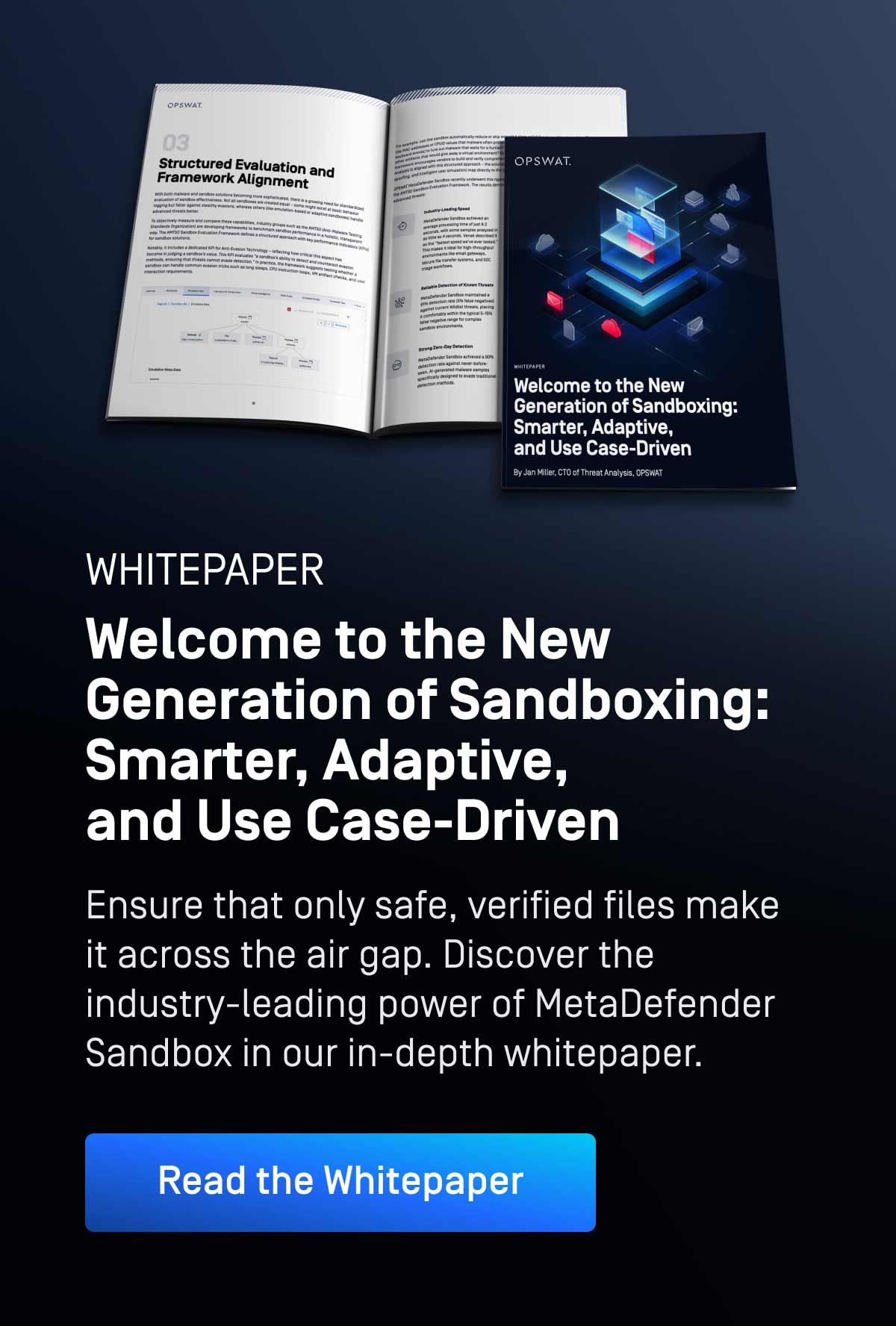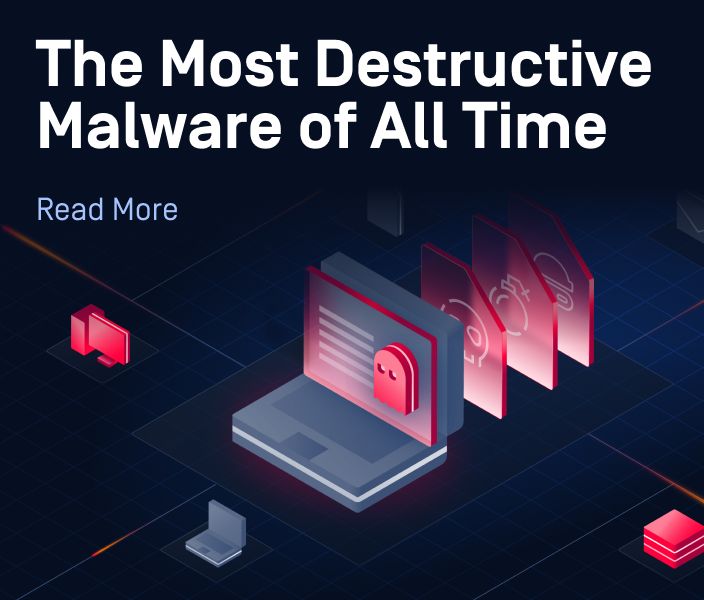What is Enhanced Threat Detection?
Enhanced threat detection refers to the use of advanced techniques like AI, behavioral analytics, and anomaly detection to identify cyberthreats earlier and more accurately. Unlike traditional threat detection, which often relies on signature matching, enhanced approaches are proactive, adaptive, and designed to catch novel threats such as zero-day attacks.
Core Concepts of Threat Detection
Enhanced threat detection builds on several foundational capabilities:
- Real-time threat detection to monitor for immediate risks
- Behavioral analytics to detect deviations in user or system activity
- Anomaly detection using machine learning to spot suspicious patterns
- Threat intelligence to enrich detection with contextual insights
For deeper insights into evasive malware tactics and how OPSWAT’s technology is evolving to meet them, download our MetaDefender Sandbox whitepaper.
Why is Threat Detection and Response Important?
Cyberattacks today are more sophisticated, faster, and often target critical infrastructure. Organizations need enhanced detection to stay ahead of these evolving threats.
When paired with rapid response, effective threat detection minimizes downtime, data loss, and reputational damage.
TDR (Threat Detection and Response) Explained
TDR is a proactive cybersecurity strategy. It identifies threats as they emerge and guides appropriate responses, often through automated processes. TDR is tightly integrated with:
- Incident response plans for containment and recovery
- Vulnerability management to reduce exploitable attack surfaces
These integrations allow organizations to move from reactive to predictive security.
How Does Enhanced Threat Detection Work?
Enhanced detection works by embedding smart, scalable detection at every stage of data flow, from network entry to in-depth analysis.
One essential enabler is inline scanning at the network perimeter. Tools like MetaDefender ICAP ServerTM integrate with secure web gateways, proxies, and file transfer systems to inspect and sanitize content in real time.
Example: To enable scalable, real-time scanning within the detection workflow, ICAP-compatible tools like MetaDefender ICAP Server allow organizations to integrate deep content inspection directly into network infrastructure, without disrupting performance. This enables enhanced threat detection at the gateway level.
AI and Machine Learning in Threat Detection
AI powers threat detection by recognizing patterns, automating workflows, and predicting emerging risks.
- AI-powered threat detection adapts to new behaviors without human intervention
- Machine learning models detect anomalies invisible to static scanners
- Predictive analytics anticipate likely threats based on historical data
These techniques not only speed up detection but also reduce false positives.
Zero-Day Threat Detection and Advanced Analytics
Identifying zero-day threats requires observing how a file or process behaves—not just how it looks.
- Behavioral and anomaly-based detection can surface malicious activity even when no known signature exists
- Sandboxing complements machine learning by generating rich behavioral data
Example: Sandboxing enhances machine learning models by providing rich behavioral data for analysis. Tools like MetaDefender Sandbox simulate file execution in isolated environments, helping detect sophisticated threats — including zero-day exploits — by observing behavioral patterns, not captured by static scans.
Learn how MetaDefender Sandbox achieved a 90% detection rate against novel AI-generated malware and 100% success against anti-evasion techniques in our whitepaper.
Key Tools and Approaches for Enhanced Threat Detection
A robust security architecture combines several approaches for better visibility and faster response.
- MDR (managed detection and response) outsources threat monitoring and response
- XDR (extended detection and response) integrates tools across endpoints, networks, and cloud
- NDR (network detection and response) focuses on traffic analysis
- TDR (threat detection and response) combines detection capabilities with incident response workflows for faster containment
EDR vs. TDR vs. XDR vs. NDR
| Approach | Focus Area | Strengths | Best Use Cases |
|---|---|---|---|
| EDR | Endpoints | Fast response, user context | Insider threats, lateral movement |
| TDR | General | Integrated with IR processes | Real-time alerts, containment |
| XDR | Cross-layer | Unified visibility | Complex environments |
| NDR | Network traffic | Detects hidden threats | IoT, encrypted traffic analysis |
Example: Enhanced detection often requires a multi-layered toolset. MetaDefender ICAP Server provides inline scanning and content disarm at the gateway, while MetaDefender Sandbox performs deep behavioral analysis post-ingestion. Together, they support a defense-in-depth approach to detecting known and unknown threats.
Explore how this multi-layered approach has been validated through independent testing in our MetaDefender Sandbox whitepaper.
Implementing Enhanced Threat Detection: Best Practices
Rolling out an advanced detection strategy takes planning, integration, and ongoing evaluation.
Key steps include:
- Embedding detection in network and endpoint workflows
- Integrating tools with your SOC (security operations center)
- Automating response where possible
- Feeding insights back into detection models for continual learning
Threat Hunting and Proactive Defense
Threat hunting is the human-led component of detection. It involves:
- Investigating suspicious activity not flagged by automated tools
- Using threat intelligence and predictive analytics to uncover hidden risks
To learn how detection engineering supports threat hunting, see What Is Threat Hunting and Introduction to Threat Detection Strategies.
Ready to scale your threat detection capabilities? Discover how MetaDefender ICAP Server and MetaDefender Sandbox work together to protect your environment—inline and in-depth. Explore the solution now or download the whitepaper for real-world results and performance benchmarks.
Frequently Asked Questions (FAQs)
Q: Why is threat detection and response important?
A: It minimizes the damage of cyberattacks by identifying and responding to threats in real time.
Q: What is threat detection?
A: Threat detection is the process of identifying malicious activity on a system or network.
Q: What makes threat detection advanced?
A: Advanced detection uses AI, behavioral analytics, and automation to identify threats that traditional tools miss.
Q: How does threat detection work?
A: It involves data collection, real-time analysis, behavioral modeling, and threat intelligence integration.
Q: What is the threat detection and response process?
A: It includes detection, triage, containment, mitigation, and recovery.
Q: What is threat detection and response?
A: TDR is a cybersecurity approach that identifies and responds to threats through a combination of tools and workflows.
Q: How does AI enhance threat detection?
A: AI enables faster detection, reduced false positives, and adaptability to new attack techniques.
Q: What is EDR and how does it work?
A: Endpoint Detection and Response (EDR) monitors endpoints to detect, investigate, and respond to threats.
Q: What is TDR in cybersecurity?
A: TDR stands for Threat Detection and Response. It integrates detection tools with incident response strategies.



